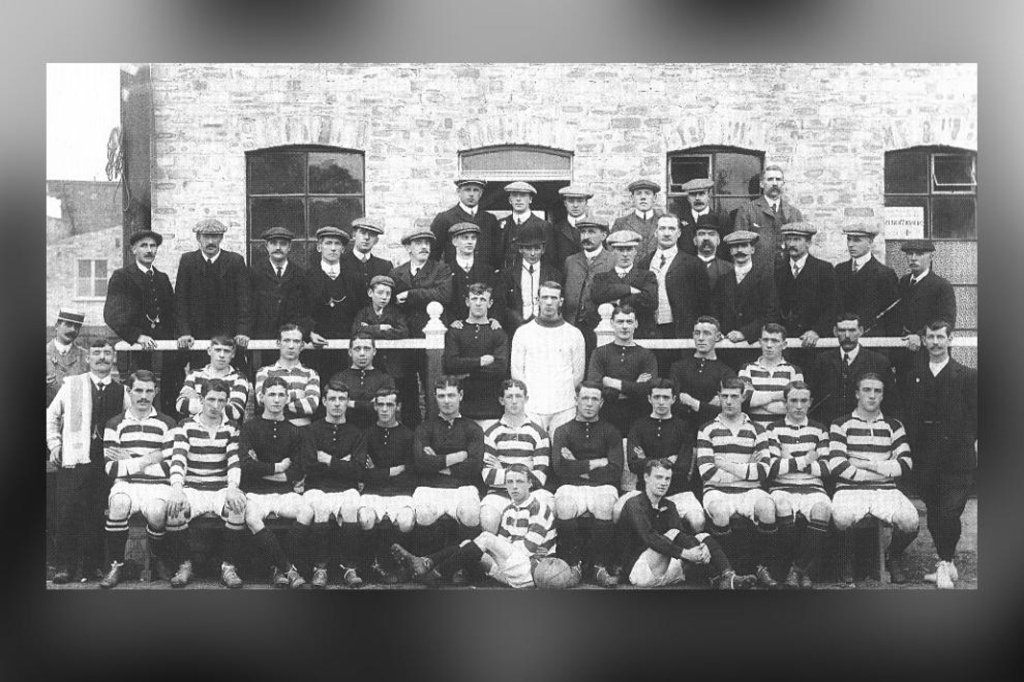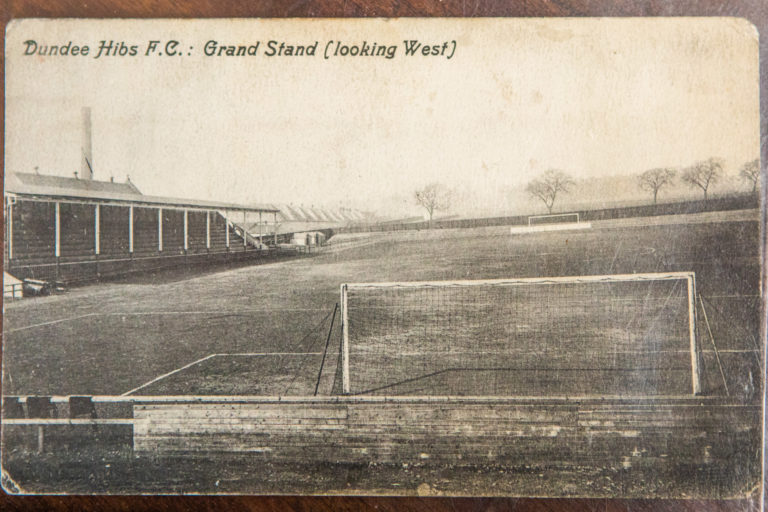By Fergus Dowd
In 1864 Dutchman James Cox built the largest Jute factory in the world in the town of Lochee just west of Dundee on the Firth of the Tay. Camperdown Works would house five thousand employees and its campanile style chimney would cover the town’s skyline; the town’s prosperity would lie solely on the textile industry and the manufacturing of Jute.
Lochee would soon have a school, two railway stations, a police station, and several chuches and the Irish would flock to the town leaving behind a land scourged by famine. Fourteen thousand would set foot in Lochee lured by the prospect of employment in Cox’s jute mills, the town would soon have the moniker of ‘Little Tipperary’. Most came skilled and knowledgable about the work leaving the linen towns of Donegal, Derry, Sligo, and Monaghan. Within forty years Lochee Harp football club would be formed following in the footsteps of the Irish in the Cowgate area of Edinburgh and the East End of Glasgow.
As the population in the area grew housing and sanitation couldn’t keep a pace with many families living in overcrowded slums and in an era before the welfare state some suffered from hunger and disease leading to a loss of regular income. Among this poverty and prosperity ‘The Harp’ was born by church leaders and members to raise much needed funds through the playing of football matches and to alleviate the boredom of the daily grind for workers.
In their first season the club would win the Dundee Junior Cup with the names of Gallagher, Mac Colla and Curran featuring prominently. Watching from the stands and immersing himself in the success was one James Connolly who had left the British Army in 1889 after serving for seven years in Ireland, to settle back in Dundee. It is in Dundee and the Irish heartland of Lochee where Connolly would begin his activism in socialist politics and trade union rights.
Connolly was born in 1868 at 107 Cowgate in Edinburgh to an Irish immigrant family close to St. Patrick’s Church where the Catholic Youth Mens Society was founded. From the embers of this society Michael Whelehan an Irish immigrant from Co. Roscommon would convince Canon Edward Hannon to allow the CYMS to form its own football club, out of this conversation came Hibernian football club in 1875.
On the football pitches across Dundee Lochee’s success would continue recapturing the local junior cup in season 1906/07 with a third title four years later. The Harp’s achievements did not go unnoticied and by March 22nd, 1909, the Scottish Referee newpaper was reporting of a new ‘Irish team’ being formed taking the name Dundee Hibernian.
“The promoters are all Dundee Irishmen, and as the city is said to include in its population no less than thirty thousand of the same persuasion, the new organisation will not want for support. Mr Pat Reilly, the well-known cycle manufacturer, has been appointed secretary. The new club is meant to take the place of the defunct Dundee Harp, which was, in its time, one of the most prominent clubs outside of Glasgow.”
Scottish Referee newspaper
By mid-May of 1909 Dundee Hibernians became sole tenants of Clepington Park on Tannadice Street, the old tenants Dundee Wanderers took everything but the grass. The local Irish community in the city would put in a mammoth effort to have the ground ready for the clubs first friendly against Hibernians of Edinburgh; a new pavilion was erected, stand and fencing while just days before the match turnstiles were purchased at a cost of £9 each with a discount of 5% sourced by paying in cash.

At 5:45 pm on Wednesday August 18th, 1909, seven thousand patrons would pay in at the turnstiles to officially open the new ground which would become Tannadice Park. Pre-match entertainment would come from the band of the Mars Training Ship for dissolute children, the music adding to the jovial occasion.
Messers Brady, Strachan, Gallacher, Hannan, Ramsay, Boland, Flood, Brown, Dailly, Docherty and McDermott would don the club’s green shirts for this inaugural outing.
Hibernians of Edinburgh who usually wore green and white hoops would borrow a kit from Leith Amatuers lining out in unfamiliar black and white hooped shirts. To watch proceedings adults would be charged 4d and children 2d the crowd primarily drawn from the forty thousand strong Irish community in the city. John O’Hara of Hibs would be the first man to net at the new stadium and after the game he would be presented with a bicycle by Dundee Hibernians founder and manager on the day Pat Reilly from his shop on Perth Road. However, forward Jamie Docherty would send the home crowd into raptures with an equalisier and as Mr. J. Winter blew the proceedings to an end the game finished in an entertaining 1-1 draw. The Edinburgh Hibernians fees amounted to £8 one shilling as darkness fell across Tayside both teams enjoyed an aftermatch cup of tea.

Disappointingly though the new ‘Irish club’ of Dundee was not welcomed with open arms by all as the Scottish Football Authorities refused an application by Reilly and Dundee Hibernian to join the Scottish League – they would line out in the Northern League facing off against their nemisis Dundee Wanderers.
This did not defer Reilly who was born in Dundee to Irish parents, the eldest of five children, the family were steeped in the bicycle trade. Pat would spend his days with his father and two brothers manufacturing two-wheeled cycles fom the ‘standard’ Triumph Roadster for ‘Sir’ to the Chater Lea X-frame for ‘the Ladies’.
Reilly began writing to all Scottish League clubs looking for support to allow Dundee Hibernians join the national league system he advised that Tannadice consisted of a “pavilion with excellent dressing rooms, hot and cold running water, a grandstand holding 1200 supporters and that Tannadice Park could hold 15,000 – 20,000 spectators.”
By 1910 the lobbying of other league clubs paid off and Dundee Hibernian started life in the second tier of Scottish football playing Leith Athletic in their opening league fixture at Tannadice, they would finish the season in 8th place with twenty-two games played and win the local Carrie Cup.
The World at War would have a profound effect on Dundee Hibernian with many players leaving for the front and financial woes leading the club to have to transfer to the Eastern Legue by 1915.
However, ‘The Irishmen’ as they were known would be reinstated to the Scottish League after the War ended in 1919 and again in 1920 but no fixture would be fullfilled by the Hibernians of Dundee.
In October 1923 as the club faced financial ruin a group of local businessmen offered the board a financial package to stop ‘The Greens’ going out of business however, it came with a price.
Those proposing the stimulus requested a change of name and colours which would appeal to a wider audience not just the Irish of Dundee. Originally the name Dundee City was put forward but frowned upon by city rivals Dundee this was then changed to Dundee United and a black and white kit would replace the green.
United kept the white and black colours until as late as 1969, when they switched to tangerine shirts and black shorts. They had worn this combination while competing as Dallas Tornado in the United Soccer Association in 1967 and it was the wife of manager Jerry Kerr who persuaded the Tannadice outfit to adopt the colours.
In November 1971 a former Lanarkshire joiner by the name of Jim McLean would replace Jerry Kerr as manager of Dundee United, he had made his name in football across the road at Dens Park.
McLean would spend twenty-two years in the hot seat at Tannadice and shake the foundations of Scottish football to its very core creating a ‘new firm’ through one of the greatest youth policies ever established in Scotland. Following League Cup victories in 1979-80 and 1980-81 McLean would lead the club that Pat Reilly founded to the promise land winning the title in 1982/83 pipping Glasgow Celtic by a point.
The title was clinched at Dens Park with a 2-1 victory, on the day McLean’s men would get changed in Tannadice Park and walk the 200 yards in their orange shirts to their great rival’s stadium.
It would mean United would line out in the European Cup of 1983/84 it would be some adventure with Sturrock, Bannon, Hegarty and Milne all starring along the way as McLean’s charges reached the semi final defeated by Italians Roma 3-2 on aggregate. An impressive two nil victory at Tannadice in the first leg was duly scratched out as United succumb to a three-nil defeat in the second leg in Rome – ‘The Irishmen’ as once they were known had dared to dream of the top prize in European club football.
Three years later Dundee United went one better reaching the UEFA Cup final of 1987, after defeating FC Barcelona in the quarter final where McLean asked those of Irish Catholic faith to pray in the Camp Nou cathedral before the game, they would narrowly lose out to IFK Gothenburg.
Today in the Tannadice boardroom you will find the original minutes book which includes the writings of those who founded the club and those who saved it; a football club founded by Irish immigrants and expanded by locals.

